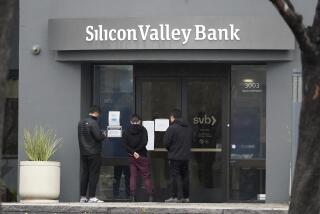$135 Million in Sham Profits Cited at Lincoln S
- Share via
WASHINGTON — Lincoln Savings & Loan generated $135 million in sham profits through overpriced sales of land to “straw” buyers, an accounting expert testified Friday in U.S. District Court here.
About half of Lincoln’s earnings between 1984 and its seizure by the government in 1989 came from the dubious sale of land in the Phoenix area, said Roger Johnson, a witness for the federal government.
American Continental Corp. of Phoenix, Lincoln’s parent, is suing the federal government to overturn the seizure of the Irvine-based S&L.; Judge Stanley Sporkin is conducting a mini-trial dealing with some of the complex real estate and tax transactions. He is trying to determine whether American Continental should be entitled to a full trial on its complaint that regulators acted unfairly in seizing Lincoln in April, 1989.
Johnson, who spent a full day on the stand for direct testimony and cross examination, said he was “shocked” by Lincoln’s “contrived transactions” in the sale of land. The S&L; “ended up having more paper than cash” after its dealings with various companies, said Johnson, a partner with Kenneth Leventhal & Co., an accounting firm.
After examining 15 transactions for which Lincoln claimed $135 million, “I felt no profits should be booked,” the accountant said. The buyers “did not have sufficient cash” in the properties purchased from Lincoln, he said. The buyer “has to have his own cash in the deal,” and if the market goes bad, he will still be “motivated to complete the deal,” according to the accountant.
One of Lincoln’s main land projects, the Hidden Valley ranch in an undeveloped section of Maricopa County west of Phoenix, is unlikely to be developed for the remainder of the century, Johnson testified. Lincoln bought the land at an average price of $3,000 an acre in 1985 and 1986, and began selling it at $16,000 an acre in 1987 and 1988, the witness said.
Johnson described the complex transactions enabling Lincoln to record hefty profits.
In March, 1987, Lincoln had an appraisal on 1,000 acres of its Hidden Valley property saying the land was worth $8.5 million.
On March 31, Lincoln sold the land to Westcontinental Mortgage & Investment, or Westcon, for $14 million and recorded a profit of $11 million. Lincoln received a $3.5-million cash down payment and a note for $10.5 million from Westcon, a company that originally had a net worth of $30,000 and assets of $87,000.
How could the buyer, Westcon, “service that type of debt?” Johnson wondered.
On March 30, a day before the land sale to Westcon, Lincoln loaned $19 million in cash to E. C. Garcia Co., a Tucson development firm. E. C. Garcia, in turn, gave a $3.5-million loan to Westcon, providing the cash needed as down payment for buying the Hidden Valley land from Lincoln.
Westcon “was operating as a straw buyer . . . (with) none of their own cash involved,” Johnson said.
In June, 1988, E. C. Garcia Co. assumed the $10.5-million note owed by Westcon to Lincoln. “I can find no evidence there was ever a payment by Westcon or Garcia on the $10.5-million note,” Johnson said.
The accountant described another deal in which Lincoln sold $6 million worth of land to Hidden Valley Limited Partnership. The partnership “was basically a shell set up with $100 in capital,” Johnson said, using funds transmitted through a series of transactions from American Continental.
In all the complex cases, Lincoln’s financial records “showed the form, not the substance,” of real sales, Johnson said.
Lincoln was “manufacturing profits by giving its money away,” Johnson said.
The failure of Lincoln may ultimately cost the government $2 billion to liquidate or dismantle the institution, the costliest case in the massive wave of S&L; shutdowns. American Continental filed for bankruptcy protection last April 13, and Lincoln was seized by federal regulators the next day.
NAMES MILKEN
Indicted junk bond trader Michael Milken and Drexel Burnham Lambert were added as defendants in a civil suit filed by Lincoln investors. D11.
More to Read
Inside the business of entertainment
The Wide Shot brings you news, analysis and insights on everything from streaming wars to production — and what it all means for the future.
You may occasionally receive promotional content from the Los Angeles Times.









